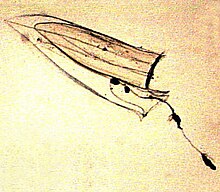
The Portuguese man o' war, also known as the man-of-war, bluebottle, or blue bottle jellyfish, is a marine hydrozoan found in the Atlantic Ocean and the Indian Ocean. It is considered to be the same species as the Pacific man o' war, which is found mainly in the Pacific Ocean.

Siphonophorae is an order of Hydrozoans, a class of marine organisms belonging to the phylum Cnidaria. According to the World Register of Marine Species, the order contains 175 species.
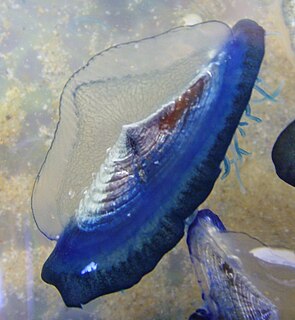
Velella is a monospecific genus of hydrozoa in the Porpitidae family. Its only known species is Velella velella, a cosmopolitan free-floating hydrozoan that lives on the surface of the open ocean. It is commonly known by the names sea raft, by-the-wind sailor, purple sail, little sail, or simply Velella.

Marrus orthocanna is a species of pelagic siphonophore, a colonial animal composed of a complex arrangement of zooids, some of which are polyps and some medusae. It lives in the Arctic and other cold, deep waters, swimming independently in mid-ocean. It is a colonial creature that is born from a single egg which is fertilized. Later on, a protozoan form that eventually grows to form more duplicating members of the colony.

Marrus is a genus of siphonophores. Species include:

Agalmatidae, or Agalmidae, is a family of siphonophores.
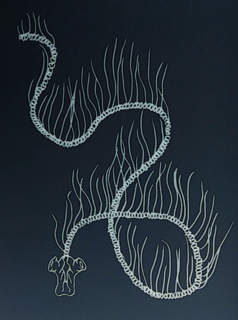
Prayidae is a family of marine invertebrates in the order Siphonophora. They are colonial, and the colonies can superficially resemble jellyfish; although they appear to be a single organism, each specimen is actually a colony of Siphonophora.

Apolemia is a genus of siphonophores. It is the only genus in the monotypic family Apolemiidae.
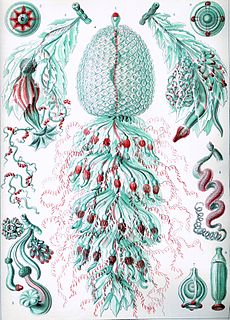
Forskalia is a genus of siphonophores. It is the only genus in the monotypic family Forskaliidae.

Dendrogramma enigmatica is a species of siphonophore, the only one in its genus. It has been first described in 2014 on the basis of its morphology from a collection of specimens gathered in 1986. Its taxonomic affinity among animals was then unclear, but RNA from new specimens in 2016 allowed it to be identified as a siphonophore by barcoding and phylogenomics. The specimens are presumed to represent parts (bracts) of an entire siphonophore that has not been identified yet.

Porpita prunella is a marine species of hydrozoan organisms within the family Porpitidae. It consists of colonies of zooids. Very little is known about this species, as there have been no confirmed sightings since its discovery in 1801 and naming by Haeckel in 1888. Being in the chondrophore group, it is likely that its behaviour is similar to the other species of the genera in the family. However there are also serious doubts as to its very existence as a separate species and may in fact be a synonym for Porpita porpita instead.

Parasagitta setosa is a small arrow worm in the family Sagittidae, previously referred to as Sagitta setosa. It is native to the northeastern Atlantic Ocean, the North Sea and the Mediterranean Sea, and also occurs in the Baltic Sea and the Black Sea.
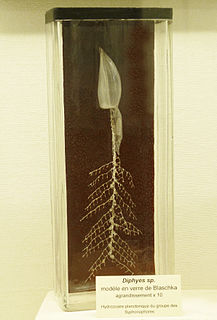
The Diphyidae are a family of siphonophores. These are colonial siphonophores with two nectophores arranged one behind the other. The front one includes a somatocyst, while the hind one does not. The somatocyst often contains an oil droplet for buoyancy control. A nectosac in each nectophore allows the organism to swim efficiently.

Muggiaea atlantica is a species of small hydrozoan, a siphonophore in the family Diphyidae. It is a cosmopolitan species occurring in inshore waters of many of the world's oceans, and it has colonised new areas such as the North Sea and the Adriatic Sea. It is subject to large population swings, and has been held responsible for the death of farmed salmon in Norway. The species was first described by J.T. Cunningham in 1892 from a specimen obtained at Plymouth, England.
Muggiaea kochii is a species of small hydrozoan, a siphonophore in the family Diphyidae.

Carinaria cristata, commonly known as the glassy nautilus, is a species of pelagic marine gastropod mollusc in the family Carinariidae. It is found in the Pacific Ocean and is described as being holoplanktonic, because it spends its entire life as part of the plankton. It was first described by Carl Linnaeus in 1767. Its fragile shell was much prized by early conchologists for their collections, being so rare that it was said to be worth more than its weight in gold.

Bathyphysa conifera, sometimes called the flying spaghetti monster, is a bathypelagic species of siphonophore in the family Rhizophysidae.

Physonectae is a suborder of Siphonophores. In Japanese it is called 胞泳.

Calycophorae is a suborder of siphonophores. The order includes the giant siphonophore, ; one of the longest lengthwise extant creatures (40–50m).
Physophoridae is a family of siphonophores.
